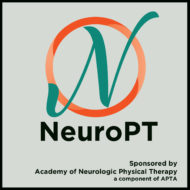In this episode, host Marissa Moran, PT, DPT is joined by author (and current Stroke SIG Nominating Committee Member!) Dr. Chitra Balasubramanian, PT, PhD, CEEAA to discuss her research article titled “Walking Adaptability after a Stroke and Its Assessment in Clinical Settings”. Dr. Balasubramanian was awarded the Stroke SIG Research Award in 2022. Dr. Balasubramanian discusses the importance of walking adaptability within the realm of stroke recovery and why assessment of this construct matters.
The information in this podcast is meant for the benefit of physical therapists. It is not meant for personal medical diagnosis and/or treatment. Individuals should always consult an appropriate medical practitioner with questions.
This is for informational and educational purposes only. It does not constitute and should not be used as a substitute for medical advice, diagnosis, rehabilitation, or treatment. Patients and other members of the general public should always seek the advice of a qualified healthcare professional regarding personal health and medical conditions. The Academy of Neurologic Physical Therapy and its collaborators disclaim any liability to any party for any loss or damage by errors or omissions in this publication. The views or opinions expressed are those of the individual creators and do not necessarily represent the position of the Academy of Neurologic Physical Therapy.
Please send comments or questions on this podcast to the Stroke SIG at strokesig@gmail.com.
The Stroke Special Interest Group is part of the Academy of Neurologic Physical Therapy – www.neuropt.com.
Podcast: Play in new window | Download (Duration: 36:17 — 29.6MB)
Subscribe: Apple Podcasts | Google Podcasts | Spotify | Pandora | iHeartRadio | Stitcher | | More

